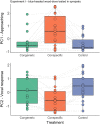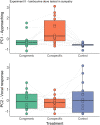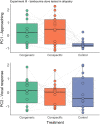Response of forest Turtur doves to conspecific and congeneric songs in sympatry and allopatry
- PMID: 37743404
- PMCID: PMC10518307
- DOI: 10.1038/s41598-023-43035-8
Response of forest Turtur doves to conspecific and congeneric songs in sympatry and allopatry
Abstract
Birds have a diverse acoustic communication system, and the ability to recognise their own species' song from a distance facilitates complex behaviours related to mate attraction and rival deterrence. However, certain species, including doves, do not learn songs and their vocal repertoires are much simpler than those of better-studied songbirds. In these so-called non-learning birds, relatively little is known about the role that bird song plays in intra- and interspecific interactions, and how such behaviours might be acquired (inherited or learned from experience). To investigate this question, we focused on two species of African wood doves whose long-range songs are used in a territorial context. Specifically, we examined the responses of sympatric and allopatric populations of male blue-headed wood-doves (Turtur brehmeri) and tambourine doves (Turtur tympanistria) to different types of simulated territorial intrusions, i.e. playback of conspecific, congeneric, and control songs. We aimed to assess (i) whether these species, which have similar songs, respond only to their own species' song or exhibit interspecific territoriality, and (ii) if the response pattern is affected by the presence or absence of congeners in the general area. We found that both species responded strongly to playback of their own species in both sympatric and allopatric populations. In allopatry, though, male tambourine doves misdirected their response and also approached the playback of congeneric songs. Our results indicate that, in areas where the studied Turtur doves live in sympatry, they do not exhibit consistent interspecific territoriality. However, we cannot exclude the possibility that the smaller tambourine dove avoids its larger congener during the process of territory establishment. The difference in tambourine doves' response toward the song of present (sympatric) or absent (allopatric) congeners suggests that the ability to discriminate between songs of similarly singing potential competitors is acquired through earlier interactions and learning. This plasticity in response supports the misdirected aggression hypothesis, which argues that interspecific territorialism emerges as a maladaptive by-product of signal similarity. However, on an evolutionary timescale, such an ability could be considered an adaptive cognitive tool useful for resolving competing interests with congeners.
© 2023. Springer Nature Limited.
Conflict of interest statement
The authors declare no competing interests.
Figures




Similar articles
-
Neighbour-stranger discrimination in an African wood dove inhabiting equatorial rainforest.Sci Rep. 2024 Feb 21;14(1):4252. doi: 10.1038/s41598-024-53867-7. Sci Rep. 2024. PMID: 38378955 Free PMC article.
-
Intra- and interspecific interactions in the two coexisting Locustella warblers revealed by song playback experiments.Behav Processes. 2024 Mar;216:104992. doi: 10.1016/j.beproc.2024.104992. Epub 2024 Jan 20. Behav Processes. 2024. PMID: 38253112
-
Asymmetric Response of Costa Rican White-Breasted Wood-Wrens (Henicorhina leucosticta) to Vocalizations from Allopatric Populations.PLoS One. 2015 Dec 15;10(12):e0144949. doi: 10.1371/journal.pone.0144949. eCollection 2015. PLoS One. 2015. PMID: 26671001 Free PMC article.
-
To Become Senders, Songbirds Must be Receivers First.Integr Comp Biol. 2017 Oct 1;57(4):910-919. doi: 10.1093/icb/icx106. Integr Comp Biol. 2017. PMID: 28985314 Review.
-
Producing song: the vocal apparatus.Ann N Y Acad Sci. 2004 Jun;1016:109-29. doi: 10.1196/annals.1298.041. Ann N Y Acad Sci. 2004. PMID: 15313772 Review.
Cited by
-
Neighbour-stranger discrimination in an African wood dove inhabiting equatorial rainforest.Sci Rep. 2024 Feb 21;14(1):4252. doi: 10.1038/s41598-024-53867-7. Sci Rep. 2024. PMID: 38378955 Free PMC article.
References
-
- Bradbury, J. W. & Vehrencamp, S. L. Principles of animal communication, 2nd ed. (Sinauer Press, 2011).
-
- Catchpole, C. J. & Slater, P. J. B. Bird song: Biological themes and variations (Cambridge University Press, 2008).
-
- Schmidt R, Kunc HP, Amrhein V, Naguib M. Aggressive responses to broadband trills are related to subsequent pairing success in nightingales. Behav. Ecol. 2008;19:635–641.
-
- Kroodsma DE, Byers BE. The function(s) of bird song. Am. Zool. 1991;31:318–328.
-
- Mennill DJ, Ratcliffe LM, Boag PT. Female eavesdropping on male song contests in songbirds. Science. 2002;296:873–873. - PubMed
Publication types
MeSH terms
LinkOut - more resources
Full Text Sources

